2023.08.02.53
Files > Volume 8 > Vol 8 No 2 2023
The influence of some ecological factors on fish diversity and abundance in Al-Huwyzah marsh / South of Iraq
1 Department of Marine Vertebrate, Marine Science Center, University of Basrah, Iraq; [email protected]
2 Department of Marine Vertebrate, Marine Science Center, University of Basrah, Iraq; [email protected]
3 Department of Biology, College of Education-Qurna, University of Basrah, Iraq; [email protected]
* Correspondence: [email protected]; (A. M. Q) [email protected]
Available from: http://dx.doi.org/10.21931/RB/2023.08.02.53
ABSTRACT
From January to December 2019, the composition of fish assemblages in Al-Huwyzah marsh was studied in various ways based on the nature of their life-history strategies. In orders to assess the impact of hydrological variations on fish assemblage composition, diversity, and abundance. Water temperature fluctuated from 12°C in January to 33°C in July. Salinity varied from 1.38 g/l in March to 3.87 g/l in November. Hydrogen ion fluctuated from 7.37 in November to 8.18 in December. Monthly fluctuations in water depth were monitored for flat sections and low-lying areas of the marsh. Fish assemblages in Al-Huwyzah marsh were studied to determine the impact of hydrological and environmental changes on the pattern, abundance, diversity, and richness of fish assemblages. Fixed, drift, and cast gillnets were used to catch the fish. Nine thousand eight hundred fifty-three fish specimens belonging to 18 species, 17 genera, ten families, and six orders were caught from the three selected stations. All of which belonged to the Osteichthyes class. Ten fish species were native, and eight were exotic species. The Abu mullet Planiliza abu was the most abundant species comprising 35.74% of the total number of species, Prussian carp Carassius gibelio 19.74% of the total caught, and blue tilapia Oreochromis aureus 19.23%. The dominance index (D3) ratio is 74.71% of the upper abundance of three fish species in the present area. The equilibrium strategists that prefer stable habitats with a long time breeding season include abundant exotic species, and opportunistic strategists comprise one species of present fish assemblage.
Keywords: Assemblage of fish; Huwyzah marsh; Hydrological variations
INTRODUCCTION
The Mesopotamian marshes in southern Iraq represent some wonderful and unique habitats with no counterpart in Asia, with various species inhabiting those marshes1,2. Marshes are the largest wetland with a diverse aquatic ecosystem in southwest Asia, covering an area of about 15,000 km2 and accounting for approximately 44 percent of Iraq's inland freshwater. The habitats of marshes vary depending on various definitive factors such as hydrology, water temperature, salinity, primary production, and nutrients3,4. The marshes are considered one of the most biodiverse areas, with many different types of life, such as aquatic plants, fish, and birds. They provide a permanent habitat for many species of waterfowl and a flyway for migrating birds between Asia, Africa, and Siberia5. In addition to being a significant economic resource for human communities, marsh residents typically build their homes out of the plants that grow in the marsh and engage in fishing and animal husbandry; they are also popular tourist destinations for recreational and sport fishing6,7. The marshes dried up during the 1990s, and these processes altered the hydrological system of this wetland, causing a habitat catastrophe and the death of aquatic organisms and the destruction of biodiversity and the displacement of its inhabitants. The Al-Huwyzah marsh, which covers around 90691 hectares in Iraq, was one of the first freshwater wetlands designated as a Ramsar World Heritage site8. After 2003, the Huwyzah marsh was inundated with water like the other marshes. Still, it pointed out that hydrological modification in marshes can affect biodiversity due to the impact on the ecosystem in the marshes9. The problem is that in the recent decade, many dams have been built in the head sources of the Tigris and Euphrates Rivers basin, causing to reduction the amount of incoming water10. This situation drove hard hydrological variations, which relatively became longer, sharper, and more effective, and they have caused a significant impact on the biota in these wetlands. The fish populations suffer from extermination in flat-lying areas in the dry season1-6. In contrast, the immersion period has become shorter, with lower water levels.
No previous works dealt with fish biodiversity and the impacts of hydrological variations in Al-Huwaizah marsh before and after the drainage, which has a critical role in biodiversity. But there were, several investigations were done after the restoration of marshes in April 2003; most of them discussed fish diversity in Al-Huwaizah marsh, southern Iraq, investigated species composition and ecological indices of fishes in the restored marshes of southern Mesopotamia collected 17 fish species from Al-Huwayzah marsh11. Discussed fish assemblage in Al-Huwyzah marsh recorded 15 species and found P. abu the most abundant species forming 37.1% of total caught12. We studied the composition structure of fish assemblage in Um Alnaaj, Al-Huwyzah marsh, which caught 13 fish species and dominant Cyprinidae, represented by eight species13. Evaluating fish assemblage composition in Al-Huwayzah marsh in southern Iraq recorded 19 fish species2. This paper aims to assess the impact of hydrological variations on the composition, diversity, and abundance of fish assemblages in the Al-Huwyzah marsh due to changes in water levels (depths) throughout the year seasons.
MATERIALS AND METHODS
Description of the study area
Fish assemblages in Al-Huwyzah marsh were analyzed from January to December 2019. Three stations were selected to implement the work. Samples were collected monthly from the stations. GPS-126 Etrex type German Manufactured Company determined the locations of stations. Station 1 at N 31°40′ E 47° 40′, station 2 N 31° 35′ E 47° 35′, and station 3 N 31° 20′ E 47° 30′ from the study area.
Al-Huwyzah Marsh, located in the Maysan province at the East of the Tigris River, is about 66 km from Al-Ammarah City. The Iraqi-Iranian border passes through it, leaving nearly three-fourths of the marsh on the Iraqi side1,2. The marsh stretches about 80 km from the border to the east bank of the Tigris River (Figure 1). The stations were determined with different mesh sizes nets were used to collect samples (fixed gillnets, cast nets and seine nets). Some of the abiotic variables were calculated while the samples were being collected. Water temperature was measured with a glass thermometer (-10 to 100 °C), salinity (g/l), and pH with a Germany-made Lovibond-Sensor Direct 150. To determine water depth, the station areas were divided into flat and low-lying areas as permanent pools with the marked of fixed points to record the monthly water depth, and the average water level was labeled by centimeters. The stations contain the same species of plants and density of vegetation (Phragmites australist, Schoenoplectus litoralis and Typha domingensis) with filamentous floating algae. The marshes are generally characterized by slow water velocity and are suitable for sedimentation and water purification.
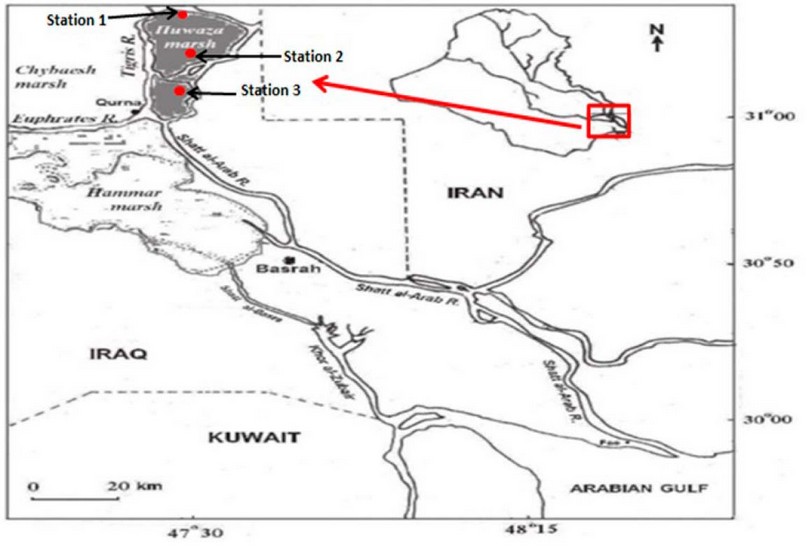
Figure 1. Map of the study area in the Al-Huwyzah marsh.
Analysis of fish assemblage
The numerical relative abundance was calculated according to Walag 14. Dominance (D3) followed by15.Fish diversity following16. Richness and evenness indices and species occurrence according to followed17. Fish were identified according to Fricke 18, and the rest of the scientific names were updated to Froese 19. The hydrological measurements included the flat areas, rivers inside the marsh, and low-lying areas as permanent pools. The average depths were labeled for three selected stations as Escalera-Vazquez:20. Response to hydrological variations and population structure patterns, species life-history strategies are identified into three categories: periodic, equilibrium, and opportunistic, according to Handhal 20,21.
Statistical analysis
The statistical correlations of variance (ANOVA) in the number of species and individuals (P≤ 0.05) among the research months and stations were calculated using the Statistical Package for Social Science-ver. Twenty programs (SPSS). The same program calculated the associations between temperature, salinity, and pH with the number of species and individuals. Pearson correlation was done among the abiotic factors in the current program.
RESULTS
This section may be divided by subheadings. It should provide a concise and precise description of the experimental results, their interpretation, and the experimental conclusions that can be drawn.
Ecological variables
The present finding showed slight monthly variations in ecological factors among the three selected stations in Al-Huwyzah marsh, as addressed in Figure (2). No significant differences (F= 0.009, 0.001 and 0.994 P > 0.05) were detected in temperature, salinity, and hydrogen-ion concentrations mean values among the three stations. Water temperature values ranged from 12ºC in January to 33 ºC in July; the (mean ±SD) values were recorded at 24±7.57. Salinity values fluctuated from 1.38 g/l in March to 3.87 g/l in November (mean ±SD) found to 2.35± 0.90, whereas hydrogen-ion values ranged from 7.37 in November to 8.18 in December (mean ±SD) values recorded 7.73± 1.32. Fish assemblage structure, composition, diversity, occurrence, and distribution in the wetlands are strongly related to hydrological variation, land topography changes, and biotic and abiotic factors. Pearson correlation revealed the relationships among the environmental variables. The analysis exhibits a weak significant positive correlation (r= 0.246) between water temperature and salinity; on the other hand, the water temperature is significantly negatively correlated with hydrogen-ion (r= -0.757**), and also significant relationship showed between salinity and hydrogen-ion (r= -0.775**).
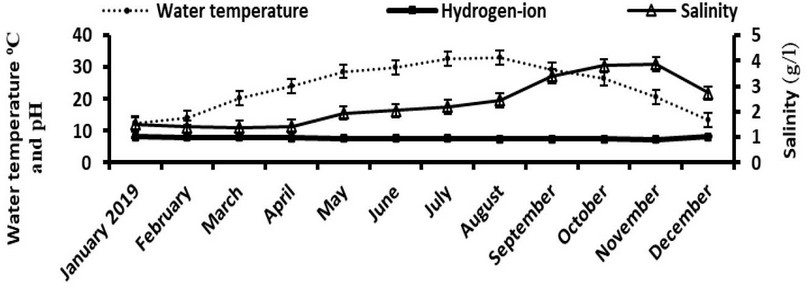
Figure 2. Monthly changes in some of the environment variables present in Al-Huwyzah marsh. Note: Error bars are standard error
Water depth
The water depth measurement in flat areas exhibits 19cm; it was labeled in October at station 2, whereas the highest depth was 112cm, shown in April at station 3. The water's average depth ranged from 23.33cm in October to 98.67cm in April, with a mean of 57.28cm±25.38. The lower water depth in low-lying areas (rivers and small pits) ranged from 61cm in October at station 1 to 189cm in April at station 3. On the other hand, the average water depth in low-lying areas varied from 64.67cm in October to 181.67cm in April, with a mean value of 120.89± 37.88 (Figure 3).
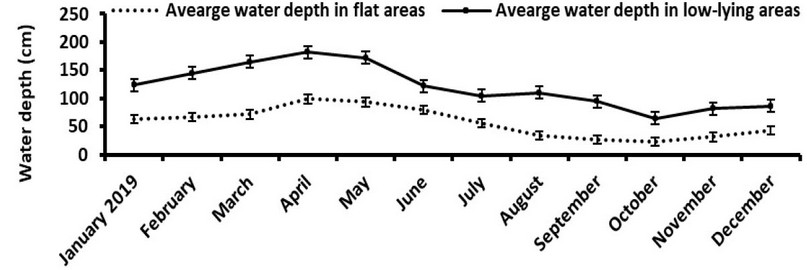
Figure 3. Monthly variations in the average water depth in the three selected stations in Al-Huwyzah marsh. Note: Error bars are standard errors.
The monthly changes in the water level exhibit an increase in the average water depth in the flat area, especially from January (63cm) to April (98.67cm), which is accompanied by an increase in the values of the diversity index from 1.68 in January to attain its peak in February and April 2.16, and 1.95 respectively, then the values of diversity index started to decline in December which recorded 1.71. The average values of the richness index started at 1.96 in January, then increased to their peak of 2.41 in March, then it took a steady level until December, which recorded 1.96 (Figure 4). The analysis revealed a negative correlation (r= -0.201) between the average diversity index and the water depth average in the study region during increased water depth (from January to April). Then the relationship takes a negative path when the water depth decreases. The exact relationship occurs with the richness index during the year's first four months (from January to April). Therefore a weak positive relationship (r= 0.172) between the average richness index and water depth average was observed (Figure 4). Generally, fish species differ in Response to hydrological variations and habitat preference despite coexistence in one habitat in the low-lying regions (permanent pools) in the dry season. Fish populations in the present wetland can split into three categories according to responding with hydrological variations depending on the differences in the life history, with evaluating these changes on fish communities' patterns. The periodic strategists (seasonally reproductive) controlled by temperature, light period, and flood season, represented in most of the native species group (Carasobarbus luteus, C. sublimus, Mesopotamichthys sharpeyi, P. abu, Alburnus mossulensis, Acanthobrama marmid, Leuciscus vorax, Silurus triostegus, Mystus Pelusius and Mastacembelus mastacembelus). Fishes that follow equilibrium strategists prefer stable habitats with a long time breeding season, represented in the abundance of exotic species (C. gibelio, O. aureus, O. niloticus and C. zillii). Still, one species has opportunistic strategists (Gambusia holbrooki) which favored dry periods in hydrological variations.

Figure 4. Monthly variations in the average water depth in flat areas with diversity and richness indices values in Al-Huwyzah marsh. Note: Error bars are standard errors.
The present study collected 18 fish species belonging to 17 genera, ten families, and six orders from the three stations, all affiliated to the Osteichthyes class. Cyprinidae, the most dominant family, participated in five fish species, followed by Leuciscidae and Cichlidae, three species of each. Seven families, Xenocyprididae, Bagridae, Siluridae, Heteropneustidae, Mastacembelidae, Poeciliidae and Mugilidae, embraced one species each. The order Cypriniformes and Siluriformes counted three families of each, whereas Synbranchiformes, Cichliformes, Cyprinodontiformes, and Mugiliformes one family for each. The fish species were broadly identified into ten native species and eight exotic fish species Table 1.
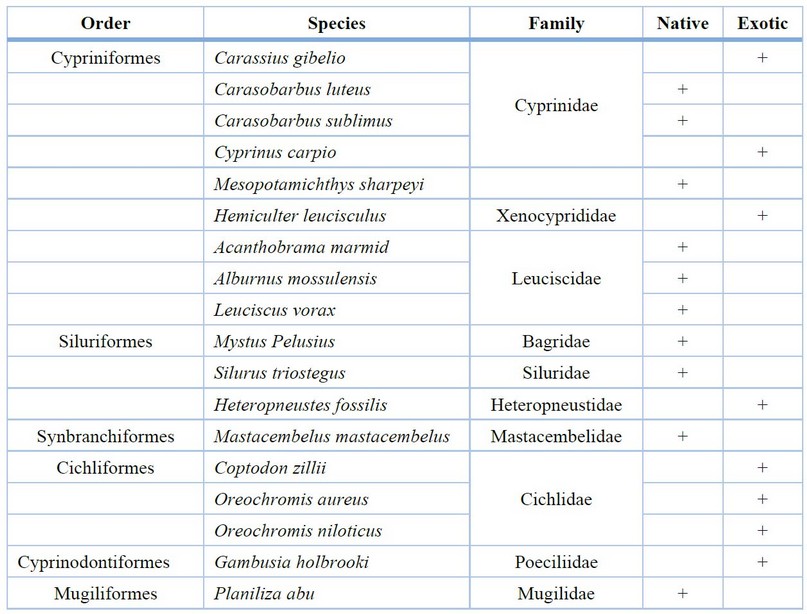
Table 1. Fish species, families and their orders with pointed native and exotic species.
The monthly variations in the number of species revealed substantial differences among the studied months in Al-Huwyzah marsh. The ANOVA analysis showed no significant differences (P > 0.05) in species presence among the selected stations. The species ranged from ten in December to 15 in February and May, with an average of 16±2.76. Generally, a wide range of monthly differences in the number of individuals was observed in the Al-Huwyzah marsh. Altogether 9853 individuals captured from the marsh ranged from 299 specimens in February to 1829 in May, with an average of 821± 495.29. No variations (P > 0.05) in the individuals' number were found between the studied locations Figure 5.

Figure 5. Monthly variations in the number of species and individuals in Al-Huwyzah marsh. Note: Error bars are standard errors.
The native species formed 55.56% of the total number of species, differing from four species in June to nine in May, while the exotic species constituted 44.44% of the total caught in the investigated area, ranging from three species in December to seven exotic species in February, March, and October Figure 6.
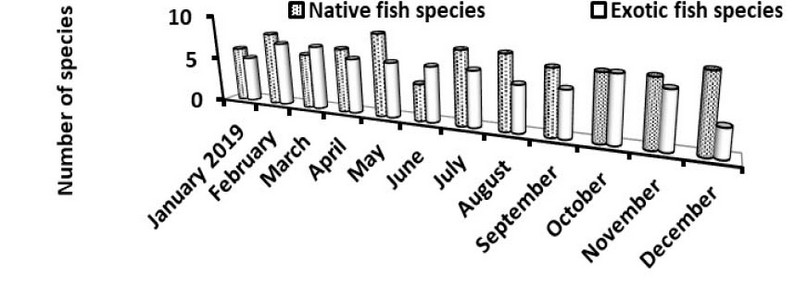
Figure 6. Monthly variations in the number of native and exotic fish species in the study area.
Relative abundance
Four species formed the highest relative abundance in the Al-Huwyzah marsh, constituting 84.64% of the total species. The species P. abu presiding the present investigated area, followed by C. gibelio, O. aureus, and C. zillii (35.73, 19.74, 19.23, and 9.94%), respectively Table 2. Three families occupied the highest rank at the families' level in the Al-Huwyzah marsh, showed 91.58% of the total caught, Mugilidae represented 35.73%, Cichlidae 34.18%, and Cyprinidae recorded 21.67%. At the same time, the lowest percentage included Xenocyprididae, Heteropneustidae, Poeciliidae, and Bagridae, formed 0.25%, 0.12%, 0.09%, and 0.08%, respectively. The dominance index (D3) for the three dominant species that sovereignty the Al-Huwyzah marsh attained 74.70% of the total species (P. abu, C. gibelio, and O. aureus). In contrast, the other species constituted 25.29% of Figure 7.
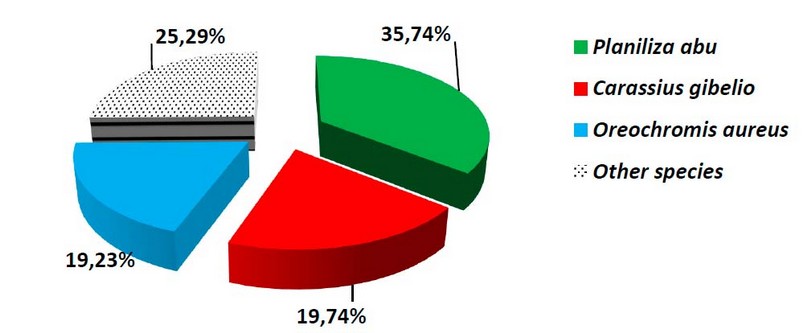
Figure 7. Dominance index (D3) of the three higher abundance species in the Al-Huwyzah marsh.
Ecological indices
Monthly fluctuations in diversity, evenness, and richness indices in the fish populations in Al-Huwyzah marsh were addressed in Figure 8. The diversity index (H) ranged from 1.54 in June to 2.16 in February, averaging 1.79. The evenness index (J) differs between 0.60 in May and 0.80 in February, with an average value of 0.72. The richness index (D) values ranged from 1.27 in December to 2.46 in February, with an average of 1.73.

Figure 8. Monthly variations in the ecological indices in the Al-Huwyzah marsh Note: Error bars are standard errors.
Species occurrence
The fish species in the Al-Huwyzah marsh were divided into three groups according to their monthly occurrence in the caught samples Table 3. The resident fish species comprised nine fish species, five of them caught in 12 months (P. abu, C. gibelio, O. aureus, C. zillii, S. triostegus) two species were caught in 11 months (L. vorax and A. mossulensis), and one species in ten months (O. niloticus). One species was sampled in nine-month (C. luteus). The seasonal fish species consisted of four fish species, two species caught in eight months (C. carpio and M. mastecembelus) and 2 of them caught in seven months (A. marmid and H. fossilis). Occasional fish constituted 5 species one species collected in five months (H. leucisculus), while another species caught in four months (M. Pelusius), one species in three months (G. holbrooki) and two species appeared in two months (C. sublimus and M. sharpeyi).
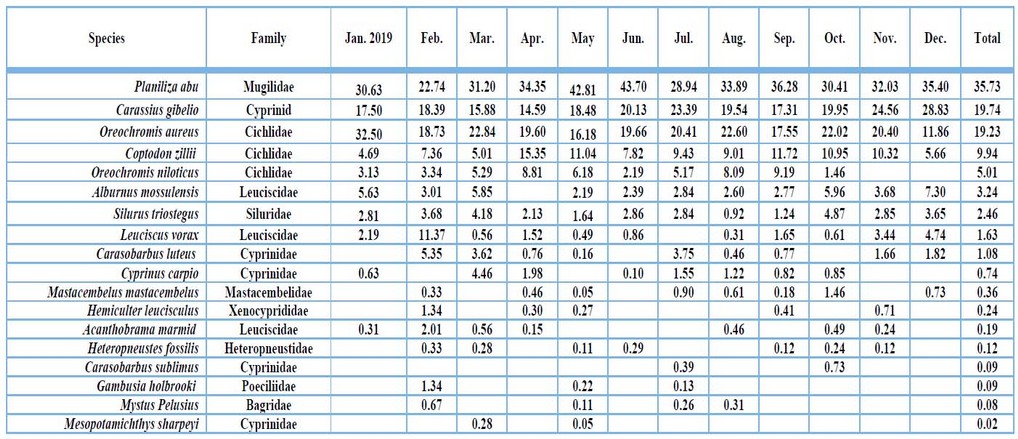
Table 2. Monthly changes in the relative abundance of fish species in Al-Huwyzah marsh from January to December 2019.
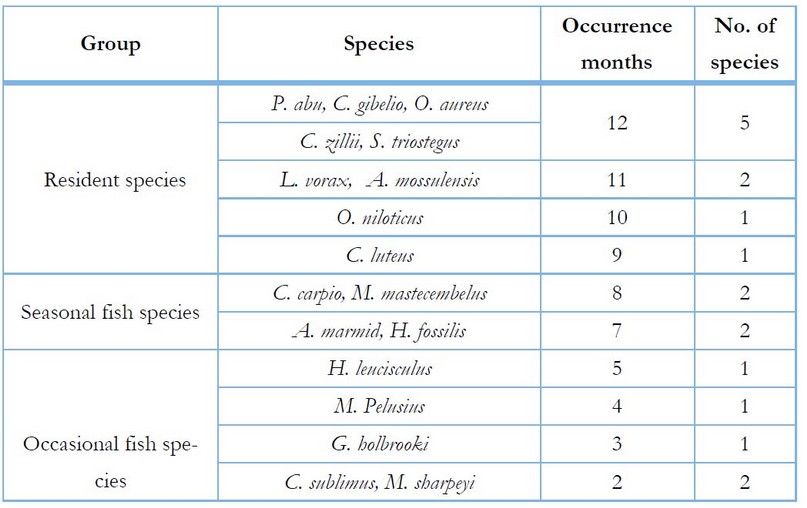
Table 3. Occurrence of fish species in Al-Huwyzah marsh from January to December 2019.
The resident fish species represented a large percentage of fish community structure (98.06%), whereas the seasonal species formed 1.41%; the percentage of rare fish species was 0.53% Figure 9.

Figure 9. Fish assemblage composition according to occurrence in the monthly catch samples in the Al-Huwyzah Marsh.
DISCUSSION
The hydrological system is characterized as a source of creating and enhancing environmental fluctuations that influence species populations and communities, and it plays an essential role in the maintenance of ecological processes in both lentic and lotic ecosystems20-22. Temperature dramatically influences the hydrological regime by controlling rainfall and evaporation processes and lowering water levels; additionally, climate change has increased the drought of the current wetland due to an accelerating rise in temperature23. Salinity is the most critical factor affecting fish's distribution, spread, survival, and declining biodiversity in aquatic habitats24. The environmental stress resulting from the deterioration specification of water quality can impact water bodies' productivity, cause altered population compositions, and change the nutrition behaviors of aquatic organisms25. The range of salinity in the current study doesn't prefer by native fish species, which represented the core of fish assemblage in the marsh, so the present results referred to a decline in abundance or absence of some sensitive inhabitant freshwater fish species26.
The Tigris River is a major water source of Al-Huwyzah marsh on the Iraqi side. The water levels increased from December to May and then decreased due to rising temperatures and the reduction of rainfall; these results were compatible with Al-Thahaibawi 2 when they found the maximum water depth of 118 cm in Al-Huwyzah marsh in April. The current study showed increasing values of diversity and richness indices with the rising water level in the marsh until March and April; it went in the reverse direction with the values of the two indices to December; these findings correspond with Yang, 27,28, when they referred to increase diversity and richness with the rising water level in some of the China rivers. Low-lying areas (rivers inside marsh and small pits) that work as permanent pools and function as refuge places for fish in dry months to mitigate the high mortality in the fish populations in the dry season; however, the periodic strategists tend to exhibit exploit the spatial and temporal changes in related to habitats quality to advancement survival of small individuals20-28. The current results documented 18 species from Al-Huwyzah marsh after inundation in 2003; these results concurred with the number of species when they recorded 17 fish species in the Al-Huwyzah marsh11. The present paper agrees with other studies executed after inundation in southern restored marshes in 2003, especially in the number of species, despite slight differences that may be related to fishing methods and tools. Still, there are considerable variations in species composition due to entered new introduce/exotic species.It was pointed out by11 18 fish species in Al-Huwyzah marsh, five of them were exotic species. While it was recorded 15 fish species, three among them were exotic species12; Also collected 13 species were, three were exotic in Um Al-Naaj in Al-Huwyzah marsh13. However, in recent years, the number of exotic species has increased versus a decline in native species. documented 19 species, including eight exotic species among them, and these results corroborate findings in the present paper that documented 18 species, including eight exotic species2. The local species P. abu recorded high relative abundance attributed to many reasons including, it characterized by small size body, high fecundity, high tolerance to unsuitable conditions, and availability of food1-6. The current paper noted that the species followed the equilibrium strategy, including exotic species, such as (O. aureus, C. zillii, and C. gibelio) trying to maintain their high abundance (numerical superiority) by following certain tactics like the temporal elongate of the reproductive season, parental care (O. aureus) and reproduction in small ages or sizes. The present result of the dominance index coincides with12 in the status of presiding P. abu and C. gibelio. In contrast, it differs from the other researchers13 in the state of C. luteus according to spatial and temporal variations between the two papers. In the flat areas and temporary pools in the dry period, all fish communities are subject to mortality, whereas in permanent pools, like deep rivers and pits, exposed fish species are to overcrowding and isolation with the high abundance that leads to a lack of oxygen concentrations and the spread of disease27,28. In terms of relative abundance, the current results concur with6 in Al-Chibaysh marsh in presiding the species P. abu, C. gibelio, O. aureus and C. zillii and partially with11,12 due to temporal variations and continued entry of new exotic fish species; the present study observed that, at the beginning of the immersion season, a decline in the abundance of all populations species with a small size spectrum of individuals. The current study showed that the resident native species P. abu was the most abundant because these species evolve strategies that enable the species to pass the dried period in hot months, when the high temperature, and low water level, the species can inhabit shallow, crowded areas, with low oxygen concentrations, and developed adaptations that enable it to survive under the extreme condition, such as small body size6. After inundation in 2003, several authors, corresponding with the current finding, expressed that P. abu is the most abundant species in the Al-Huwyzah marsh as recorded at 36.22%11, 37.10%12, 38.10%2 of the total number of species. The exotic species C. gibelio, O. aureus, and C. zillii presiding the subsequence ranks due to its possess high tolerance to extreme environmental conditions and a wide range of food elements with a long reproduction season in addition to parental care of some of these species (O. aureus)6.The ecological indices values in the present work region resemble those recorded from other wetlands and rivers in inland freshwater. Diversity index values refer to poor status according to index range, evenness index values tend to be semi-balanced, whereas richness index values are revealed to be half-complementary; these consequences congruous in general trend with several authors in southern Iraq, in Al-Chibaysh marsh6, and in Al-Huwyzah marsh2. But, there are slight differences in ecological indices Um-Al-Naaj at Al-Huwyzah marsh13 due to spatial and temporal variations and fishing methods. The present results showed the presence of nine resident species exactly in covenant with the finding when they found nine native species2; also, the present paper showed that P. abu, C. gibelio, C. zillii, S. triostegus, and O. aureus appeared in all the monthly samples and this completely agree with previous studies results. The present study affirms that the different fish species respond to hydrological variations according to their habitat preference and depending on the intensity of those changes. Fishes follow various strategies for reproduction and survival with distinction construction patterns of their populations5. Interestingly, fish communities are more complex under drought and flooded conditions due to harsh conditions represented by biotic and abiotic factors like inter and intraspecific competition and subjected species to diseases, predation, isolation, crowding and water level fluctuations20-30. The current paper recommends storing floodwaters' rainfall in the winter season and flooding those wetlands during drought. Digging more rivers inside the marsh or ponds to be permanent pools that fish refuged to in times of drought.
Hydrological variations play a crucial role in building fish population patterns in habitats subject to seasonal hydrological changes and have developed different strategies for breeding and surviving within these extreme conditions. In general, although the presence of different fish species in one pool in low-lying areas in the dry period represents a refuge for the species, their environmental preferences are different; despite these wetlands may face continuous hydrological changes during the year, but the results in the current study indicate stability in abundance, diversity, and richness during the year as a result of the species adaptation and resistance to hydrological variations.
CONCLUSION
The study concluded the differences in the fish species and their Response to hydrological variations according to the different strategies of life history patterns and divided the fish community into three categories. The periodic strategists (seasonally reproductive) included most native species.
Funding: "This research received no external funding."
Acknowledgments: The author thankful department of Marine Vertebrate, Marine Science Center, University of Basrah; the researcher also extends thanks and gratitude to all the fishermen and people who have helped to achieve the work in Al-Huwyzah Marsh.
Conflicts of Interest: The authors declare no conflict of interest.
REFERENCES
1. Mohmed, A.R.M.& Hussain, N.A. Evaluation of fish assemblage environment in Huwazah marsh, Iraq using integrated biological index. International Journal of Current Research, 2014; 6(4): 6124-6129.
2. Al-Thahaibawi, B.M.H.; Younis, K.H.; Al-Mayaly, I.K.A. Fish assemblage structure in Al-Huwaizah marsh southern of Iraq after inscribed on the World Heritage List. Iraqi Journal of Science, 2019; 60(7): 1430-1441.
3. Moomaw, W.R.; Chmura, G.L.; Davies, G.T.; Finlayson, C.M.; Middleton, B.A.; Natali, S.M.; Perry, J.E.; Roulet, N.; Sutton-Grier, A.E. Wetlands in a Changing Climate: Science, Policy and Management. Wetlands , 2018;38: 183-205.
4. Debela, M.T.; Wu, Q.; Li, Z.; Sun, X.; Omeno, O.; Li, Y. Habitat suitability assessment of wintering herbivorous anseriformes in Poyang Lake, China. Diversity. 2021; 13(4):171 https://doi.org/10.3390/d13040171.
5. Grubh. A.R.& Winemiller, K.O. Spatiotemporal variation in wetland fish assemblages in the Western Ghats region of India. Knowles. Manage. Aquatic. Ecosystem. 2018; 419(35): 1-12.
6. Abdullah A.H.J. Fish assemblage and impact of oscillation between drowning and drought on fish size-spectrum in the Al-Chibyaish marsh, southern Iraq. Iraqi Journal of Science, 2019; 60(1):18-28.
7. Ali, A. F., Mohammed, Th. T. & Al-Bandar, L. K. Effect of adding different levels of Optifeed®, Vêo® Premium and Oleobiotec® to the diets as appetite stimulants in the production and physiological performance of Male broiler under heat stress conditions. Plant Archives, 2019; 19(1): 1491-1498.
8. UNESCO office for Iraq. The marshlands of Iraq inscribed on UNESCO's world heritagelist.Availablehttp://www.unesco.org/new/en/iraq-office/about thisoffice/singleview/news/the_marshlands_of_iraq_inscribed_on_unescos_world_heritag/.2016.
9. Bassi, N.; Kumar, M.D.; Sharma, A; Saradhi, P.P. Status of wetlands in India: A review of extent, ecosystem benefits, threats and management strategies. J. Hydr. Regional Stud., 2014; 2: 1-19.
10. Mohamed, A. R. M.& Abood, A. N. Dispersal of the exotic fish in the Shatt Al-Arab River, Iraq. J. Agric. and Veter. Sci., 2017; 10(8):50-57.
11. Hussain, N. A.; Saoud, H.A.; AL-Shami, E.J. Species composition and ecological indices of Southern Mesopotamica, Marsh Bulletin, 2008; 3 (1): pp.17-31.
12. Mohamed, A. R. M.; Hussain, N. A.; Al-Noor, S. S.; Mutlak, F. M.; Al-Sudani, I. M.; Mojer, A. M.; Abdad, M. A. Fish assemblage of restored Al-Hawizeh marsh, southern Iraq. Ecohydrology & Hydrobiology, 2008; 8(2-4): 375-384.
13. Youns, K.H., Al-Mossawy, M.H.; Jabir, A.A. Composition structure of fish assemblage in Um Alnaaj, Al-Hawaizah marsh, Iraq. J. Basrah Researches Sciences. 2011; 37(2): 49-59. (In Arabic).
14. Walag, AMP& Canencia, M.O.P. Physico-chemical parameters and macrobenthic invertebrates of the intertidal zone of Gusa, Cagayan de Oro City, Philippines. Adv. Environmental Sci. Int. J. Bioflux Soc., 2016; 8: 71-82.
15. Kwak, T.J.& Peterson, J.T. Community indices, parameters, and comparisons. Analysis and interpretation of freshwater fisheries data. American Fisheries Society, Bethesda, Maryland, 2007; PP. 663-777.
16. Huang, J.; Huang, L.; Wu, Z.; Mo, Y.; Zou, Q.; Wu, N.; Chen, Z. Correlation of fish assemblages with habitat and environmental variables in a headwater stream section of Lijiang River, China. Sustainability, 2019; 11(4): 1-14.
17. Nyitrai, D.; Martinho, F.; Dolbeth, M.; Baptista, J.; Pardal, M. Trends in estuarine fish assemblages facing different environmental conditions: combining diversity with functional attributes. Aquat. Ecol., 2012; 46: 201-214
18. Fricke, R.; Eschmeyer, W.N.; Van der Laan, R (eds). Eschmeyer's catalog of fishes: genera, species, references. (http://researcharchive.calacademy.org/research/ichthyology/catalog/fishcatmain.asp). Electronic version accessed dd mmm, 2021.
19. Froese, R.& Pauly, D. Editors. FishBase. World Wide Web electronic publication. www.fishbase.org, version, 12/2020.
20. Escalera-Vazquez, L.H.; Calderon-Cortes, N.; Zambrano-Gonzalez, L. Fish population responses to hydrological variation in a seasonal wetland in southeast Mexico. Neotropical Ichthyology, 2017; 15(2): 1-9.
21. Handhal , N. A.; Ahmaed, A. S. . A Survey Study To Isolate Some Pathogenic Bacteria For Cooked Rice At Baghdad City. Journal of Life Science and Applied Research. 2020, 1, 54-59..
22. Bower, L.M.; Keppeler, F.W.; Cunha, E.R.; Quintana, Y.; Saenz, D.E.; Lopez-Delgado, E.O.; Bokhutlo, T.; Arantes, C.C.; Andrade, M.C.; Robertso, C.R.; Mayes, K.B.; Winemiller, K.O. Effects of hydrology on fish diversity and assemblage structure in a Texan Coastal Plains River. Transactions of the American Fisheries Society. 2019; 148:207-218.
23. Malinowski, L.& Skoczko, I. Impacts of climate change on hydrological regime and water resources management of the Narew River in Poland. J. Ecolog. Engin. 2018; 19(4): 167-175. DOI: https://doi.org/10.12911/22998993/91672.
24. Dasgupta, S; Huq, M.; Mustafa, M. G.; Sobhan, I.; Wheeler, D. The impact of aquatic salinization on fish habitats and poor communities in a changing climate: Evidence from southwest coastal Bangladesh. Ecological Economics. 2017; 139: 128–139.
25. Zhou, Z.; Hu, F.; Li, W.; Yang, X.; Hallerman, E.; Huang, Z. Effects of salinity on growth, hematological parameters, gill microstructure and transcriptome of fat greenling Hexagrammos otakii. Aquaculture, 2021; 531, 735945. doi: 10.1016/j.aquaculture.2020.735945.
26. Al- Zaidy, K. J. L.& Parisi, G. Re extrapolation for the Iraq marshes which falling within the world heritage list (A literature review). Al-Qadisiyah Journal of Agricultural Science, 2018; 8(2):65-82.
27. Chea, R.; Pool, T.K.; Chevalier, M.; Ngor, P.; So, N.; Winemiller, K.O.; Lek, S.; Grenouillet, G. Impact of seasonal hydrological variation on tropical fish assemblages: abrupt shift following an extreme flood event. Ecosphere, 2020; 11(12): e03303. 10.1002/ecs2.3303.
28. Yang, B.; Dou, M.; Xia, R.; Kuo, Y; Li, G.; Shen, L. Effects of hydrological alteration on fish population structure and habitat in river system: A case study in the mid-downstream of the Hanjiang River in China. Global Ecology and Conservation, 2020; 23: e01090.
29. Abdullah S.A.; Abdullah, A.H.J., Al-Ankush M.A. Assessment of water quality in the Euphrates River, Southern Iraq. Iraqi Journal Agricultural Science, 2019; 50(1):312-319.
30. Molina, A.; Duque, G.; Cogua, P. Influences of environmental conditions in the fish assemblage structure of a tropical estuary. Mar. Biodivers., 2020; 50(5): 1-13.
Received: May 15, 2023/ Accepted: June 10, 2023 / Published: June 15, 2023
Citation: Abdullah , A.H.J.; Qasim , A.M.; Adullah , S.A. The influence of some ecological factors on fish diversity and abundance in Al-Huwyzah marsh / South of Iraq. Revis Bionatura 2023;8 (2) 53. http://dx.doi.org/10.21931/RB/2023.08.02.53
